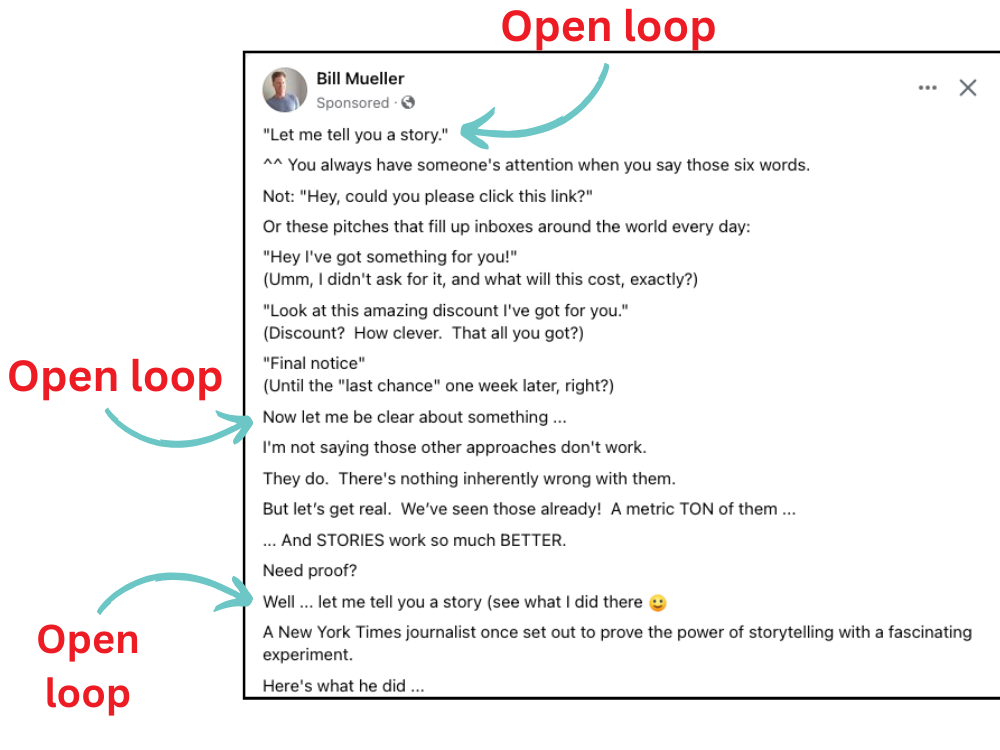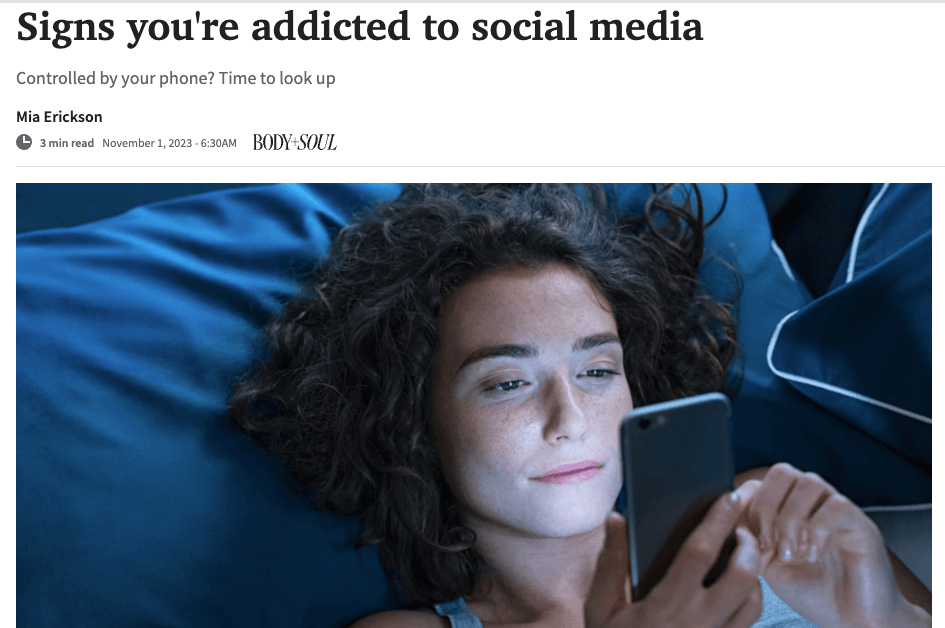An open loop is a copywriting technique that builds intrigue. The idea is to “open” a loop the person reading is so desperate to “close” that they can’t help but continue reading.
For example, within the copy, you might start a story but stop halfway through it, ask a question but not immediately answer it, or promise to reveal something later on. The technique is designed to hook the reader and keep them glued to the page for as long as possible.
Where Does An Open Loop Come From?
Open loops are commonly used in marketing and copywriting – but they originally came from film and television. If you’ve ever binge watched an entire series in one sitting, chances are the writers were very good at using open loops at the end of each episode.
You know what I’m talking about – those annoying cliffhangers where something shocking happens but they don’t reveal exactly what until the next episode.
For example, the protagonist might get shot and the episode cuts out as they’re rushed to hospital, leaving you desperate to find out whether or not they survive.
Or maybe your favourite character opens the door to their home and gasps before it fades to black. You have to watch the next episode to find out whether they’ve caught their spouse cheating on them, have been robbed, or simply forgot to take the trash out and the bin has fallen over.
Or perhaps the hero gets his hand cut off and finds out the villain he is trying to defeat is his father (Empire Strikes Back, anyone??). Whatever the case, you’re left with a question – or questions – you want answered enough to keep watching the next instalment.
How Do You Write An Open Loop In Copywriting?
There are two main ways to write open loops. The first is to write multiple pieces of content and leave open loops in each one that you close in another piece. This convinces people to binge your content. The second way is to use open loops within the same piece of writing by creating intrigue towards the beginning. This convinces someone to continue reading until the end so they can get closure on what you’re talking about.
Let’s look at some examples of each.
Open Loop Examples In Advertisements
Open loops are a fantastic technique if you’re an ad copywriter. You can use one at the very beginning of your ad to stop the scroll and convince people to read it. The same goes if you’re writing an ad script. Promising something up front, or starting a story that drives intrigue, can increase engagement with your ad.
Take the Facebook ad below, for example. There are numerous open loops created at the start – in fact, the ad itself is about an often-used open loop in copywriting – the phrase, “Let me tell you a story.” When you hear this phrase, you want to know what comes next, because there’s a good chance it’ll be memorable or entertaining. But there are other open loops within the copy that keep you scrolling down to read the rest.

You can also write an open loop towards the end of your ad that convinces people to click through to your landing page. It doesn’t have to be earth-shattering – if they’ve read to the end you’ll already have their attention, so a small nudge can convince them to click.
Simply tease something valuable or interesting that you’ll reveal on the next page, like a bonus you’re giving away with the book you’re selling. People will want to click the ad to find out more about it.
Open Loop Subject Line Examples
If you want to write better email subject lines, start using open loops. You’ll almost immediately see an increase in your open rates. If you use curiosity, people will want to open the email to read what’s inside and close the loop you’ve opened in their minds.
Here are some examples of subject lines that use open loops:
- The surprising truth about a vegan diet
- The supplement that finally cleared up my skin
- That time I met Hugh Jackman
- Fat Elvis leaves a lesson for us all
All of these either open a story or create intrigue about something you want to know more about, convincing you to open the email and read what’s inside.
Email Body Content Open Loop Examples
You don’t have to save open loops for your subject lines – you can write them inside emails, too. Doing so can increase engagement with your subscribers and convince someone to open your next email before you even send it.
A good place to do this is in the P.S. of your email. Simply say something like:
P.S. We’re launching a new supplement next week… we can’t tell you exactly what it is now, because our boss will throw a tantrum. But here’s a hint: it’s easy to take, tastes delicious AND makes your hair silkier and smoother than you’d ever believe possible! Keep an eye on your inbox for the announcement.
Open Loop Headline Examples
If you want to see examples of open loops in headlines, you only have to look at a magazine or newspaper stand. Gossip magazines and tabloids are incredibly effective at using intrigue and curiosity to convince people to buy them. They use the same principles online, combining images with explosive headlines to drive the click.
Take a look at the open loop headline example below. It reads “Signs you’re addicted to social media” and it’s paired with a very relatable image of someone in the dark, scrolling on their phone. Anyone who spends late nights going through social media on their phones is now thinking, “Am I addicted to social media?” They’ll want to keep reading the article to find out.

In copywriting, an open loop headline is a fantastic tool if you want people to continue reading. For example, if you’ve got a lead magnet you want people to download, you could write an intriguing squeeze page with a headline and supporting copy that teases what’s inside. If the headline has a compelling open loop, people will be so keen to read the lead magnet they’ll opt into your lead form.
Open Loops Inside Blog Articles
Website and blog engagement are important metrics. The longer you keep someone on your site, the more chances you’ll have to convert them into a paying customer. Plus, high engagement signals to search engines such as Google that people like your website, so they should rank it higher in their results pages. So it’s a great copywriting technique for your SEO.
One way to do this is to create a network of internal links between your blog posts and other pages on your website. This not helps keep people on your website and has a lot of SEO benefits (in fact not using links is a huge SEO copywriting mistake). You can do this in an obvious way, by adding ‘suggested posts’ at the end of every article. But you can also do it more subtly by weaving internal links inside your articles.
Let’s say, you’re writing an article about the difference between copywriter and copyrighter (which so many people seem to get confused by). In that article you can outline what each of those terms refers to and what the difference is… but some people reading might want an even more detailed version of what a copywriter does all day – so you could include a link to an article that outlines exactly that and direct people across to it. This will keep people engaged and they’ll stay on your website longer.
Open Loop Examples In Social Media Posts
Open loops in social media posts can increase engagement and even boost sales. One idea you could use would be to do a series of posts over time with a set theme.
Let’s say, for example, you’re an eCommerce brand that wants to run sales across the Christmas period. You could do a series of posts over 12 days in the lead-up to Christmas, and use the theme “12 deals of Christmas.”
Every day you announce a new deal, then drop a hint about what will be on sale the following day. People will want to see what’s coming, in case it’s their favourite product – so they’ll subscribe and return to your socials to see what it is! It’s an effective way to use open loops in your copywriting to drive engagement and make more money for your brand.
Summing Up
Open loops or cliffhangers are effective copywriting techniques. You can use them within pieces of content, or across multiple pieces of content, to keep people hooked and eager to read more. Just remember to make sure you do eventually close the loop – keeping people hanging forever will turn your content into clickbait and erode trust in your brand.
If you’re sick of researching copywriting techniques and want someone else to do the hard work for you, you can always hire a copywriter instead. Contact us for a free chat today.
